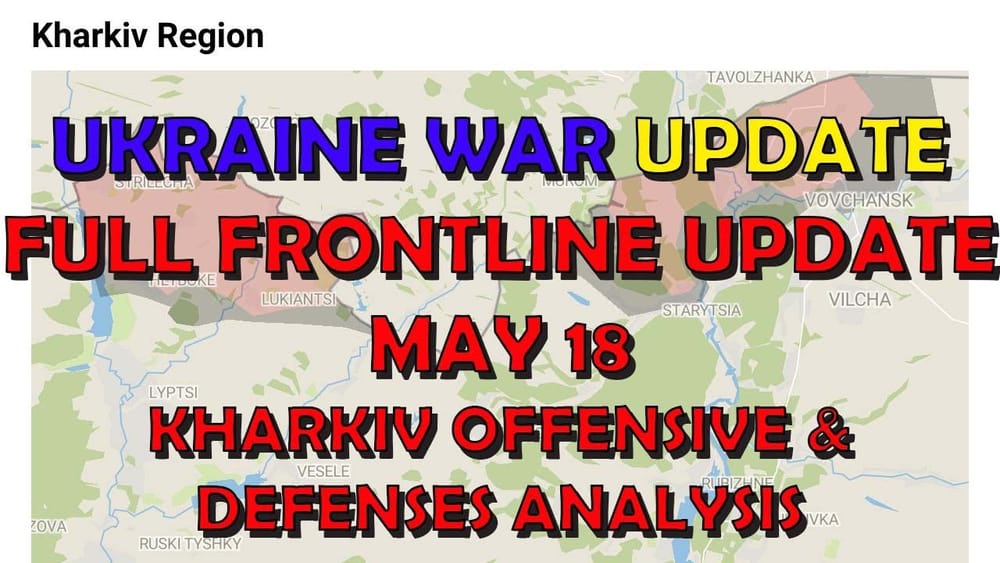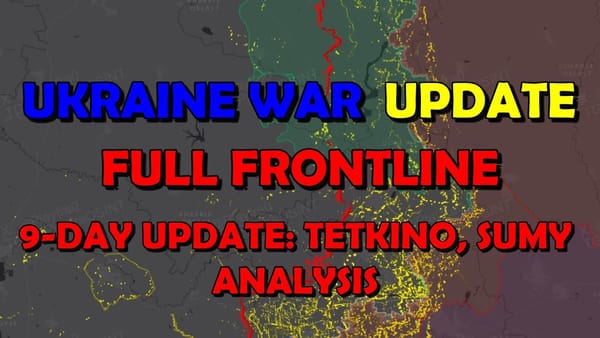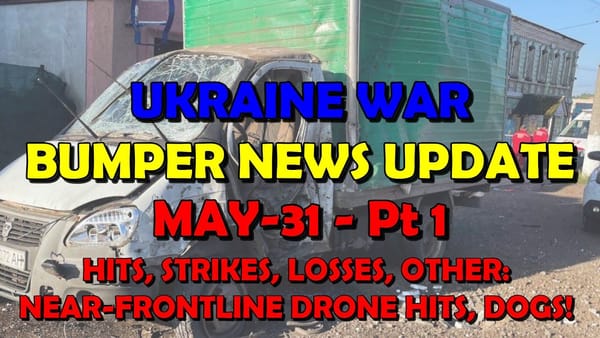Ukraine Conflict: Full Frontline Update, Kharkiv Offensive ANALYSIS
Table of Contents 📖
"Just because they [the Russians] might have an objective, it might be a plan... it's actually very good... there is a very strong chance it's not very good."
Hello Team
🎦 00:00-00:42⏩
Jonathan enjoys a cup of "crouth campo" tea, reminiscent of his time in Gibraltar. He notes the high volume of activity on the frontline and acknowledges that while his previous day's positive outlook on Ukraine might seem contradicted, their situation, though currently dire, is expected to improve with incoming aid and mobilization.
Return to top⤴️
📍 FRONT-LINE UPDATE -🗺️ MAP LEGEND

Analysis of Russian Strategy and Imposter Syndrome
🎦 00:42-07:19⏩
- Jonathan reflects on the accuracy of his past analysis, finding reassurance in the alignment of his views with those of a respected military expert, Anders Puck Nilsson, whose recent video echoed his own assessments.
- He questions the effectiveness of Russia's current offensive strategy, characterized by thinly spread forces attacking on all fronts. This approach deviates from the principle of concentrated force, and its success is doubtful.
- He speculates that the Russians might be overextending themselves, particularly in their northern offensive near Kharkiv. He believes the 50,000 troops deployed there could have been better utilized by concentrating them on key targets like Chasiv Yar.
- Jonathan highlights the potential influence of personal agendas among Russian commanders, suggesting that individuals like Lapin and Prigozhin might be prioritizing personal goals over sound military strategy to prove their worth or advance their careers.
- This, combined with the recent change in Russian military leadership, leads him to believe that the situation for Russia might be less favorable than they portray.
Ukrainian Success in Lyman Sector
🎦 07:19-10:35⏩
- Ukrainian forces have achieved a victory in the Lyman sector, west of Kreminna, repelling Russian advances and inflicting heavy losses. - A contributing factor to this success was the redeployment of Russian troops north for the Kharkiv counter-offensive, which presented the Ukrainians with an opportunity. - Despite being outnumbered two-to-one, the Ukrainians effectively utilized drones and strategically placed mines to disrupt Russian logistics and weaken their offensive capabilities.
- The Ukrainians exploited the distraction and depletion of Russian forces to launch a surprise infantry attack, catching them off guard without body armor and ultimately forcing a surrender. This victory, while not strategically decisive, demonstrates the impact of initiative, planning, and tactical surprise.
Russian Gains Near Vovchansk and Ukrainian Strikes
🎦 10:35-14:49⏩
- Jonathan analyzes the situation in Vovchansk, noting that the Russians appear to have secured a foothold in the city, particularly around the central hospital. He points out discrepancies in the control depicted by different map sources.
- Footage emerges of Ukrainian forces targeting the Vovchansk Central Hospital, where Russian forces are stationed, with US-supplied JDAM-ER glide bombs, resulting in substantial damage.
- There is debate over whether JDAM-ERs or GLSDBs (ground-launched small diameter bombs) were used in the attack. Both systems, despite initial hype, have faced challenges in effectiveness, potentially due to jamming or tactical limitations.
- Regardless of the specific weapon used, the Ukrainians' increasing reliance on these advanced munitions is notable.
French HAMR Bombs in Belgorod and French Support for Ukraine
🎦 14:49-16:10⏩
- Russia accuses Ukraine of attacking targets in the Belgorod region, which borders Ukraine, using French-made HAMR (Highly Agile and Extended Range) guided bombs.
- Jonathan speculates that if these accusations are true, and given Emmanuel Macron's recent statements, France might be taking a more assertive role in supporting Ukraine's military efforts, potentially signaling a shift in French foreign policy towards greater independence from the US.
- He posits that such a move could serve France's strategic interests by strengthening its global standing and reducing its reliance on the US for security.
Debate over Ukrainian Defenses in Kharkiv
🎦 16:10-29:26⏩
- Jonathan addresses the criticism surrounding the state of Ukrainian defenses in the Kharkiv region, particularly regarding the lack of substantial fortifications near the border. He presents both sides of the argument. - He highlights the dangers of constructing defenses too close to the border, citing Zhenya, a Ukrainian contact, who provided firsthand accounts and visual evidence of Russian drones targeting and killing construction workers and destroying equipment. This risk compelled the Ukrainians to build defenses further back from the front lines.
- Conversely, Jonathan acknowledges the strategic vulnerability of positioning defenses too far from the border, as it allows Russian forces to advance closer to Kharkiv and utilize conventional artillery for devastating effect. This dilemma underscores the complex considerations involved in fortifying the region.
- He references messages and reports from Zhenya and other Ukrainian sources, revealing a sense of frustration and concern among soldiers who find themselves on the front lines without adequate fortifications. They question the decision-making process that led to the current situation.
- While acknowledging the existence of well-constructed defenses further back, concerns are raised about the lack of quality control, camouflage, and tactical positioning of these defenses, potentially making them ineffective against drone surveillance and attacks.
- The absence of any significant defensive structures in Vovchansk, a strategically important location, is particularly perplexing.
- Jonathan concludes that the debate over Ukrainian defenses is multifaceted, with valid points raised by both sides.
- Return to top
- ⤴️
Frontline Situation in Chasiv Yar and Bakhmut Area
🎦 29:26-37:50⏩
- Jonathan shifts his focus to the frontline situation in Chasiv Yar, acknowledging the ongoing challenges faced by Ukrainian forces.
- He cites reports from military analysts, including Tatarigami_UA, suggesting that Russian forces, despite initial gains in Chasiv Yar, have struggled to establish a firm foothold due to the Ukrainians' well-prepared defenses.
- The Russians' reliance on armored fighting vehicles in Chasiv Yar indicates an escalation in their tactics, likely in response to the Ukrainians' strong defensive positions.
- South of Bakhmut, the situation is described as more complex, with the Russians intensifying assaults toward Klishchivka. While most of these attacks have been repelled, there is an expectation of continued Russian pressure in this area.
- Jonathan examines Russian sources that acknowledge the heavy casualties their forces are sustaining in Chasiv Yar. These sources describe the fighting as a "bloodbath" and highlight the challenges posed by well-entrenched Ukrainian positions.
- Despite the difficulties, the Ukrainians are successfully holding their ground in Chasiv Yar, inflicting significant losses on the advancing Russian forces. Their resilience suggests a well-prepared and determined defense.
Ukrainian Artillery Success and Ammunition Situation
🎦 37:50-39:23⏩
- Jonathan highlights a video showing the effectiveness of Ukrainian artillery, particularly 155mm howitzers, in repelling a Russian attack near Avdiivka. The attack, involving tanks and armored personnel carriers, was thwarted by a combination of aerial reconnaissance, artillery fire, and FPV drone strikes.
- He addresses Zelensky's recent claim of no artillery ammunition shortages, a statement met with skepticism from soldiers on the ground. While acknowledging an improvement in artillery ammunition supply, particularly for 155mm guns in certain areas, Jonathan presents a more nuanced reality based on reports from frontline units.
- He emphasizes the uneven distribution of ammunition across the front line, noting that while some areas benefit from increased 155mm supplies, others still lack sufficient quantities of this crucial caliber, particularly for counter-battery operations.
- The shortage extends beyond 155mm, with a severe lack of ammunition for other artillery calibers (152mm, 122mm, 125mm) and mortars (120mm, 82mm, 81mm, 60mm), which constitute the primary firepower for most infantry units.
- Jonathan relays reports suggesting that many units receive a meager 10-20 artillery and mortar rounds per day, a woefully inadequate amount considering the intensity of the fighting.
- He concludes by mentioning the lengths some Ukrainian units go to in securing ammunition, including purchasing it with their own funds, relying on volunteers, and even organizing their own production.
Frontline Developments: Avdiivka, Ocheretyn, and Robotyne
🎦 39:23-43:46⏩
- Jonathan examines reported Russian gains northeast of Ocheretyn and towards Nova Oleksandrivka. He points out discrepancies between different map sources, highlighting the fluid nature of the frontline and the challenges of confirming territorial control. - Further south, there are claims of Russian advances in the fields near Novomykolaivka, indicating a continuation of their offensive operations.
- Jonathan analyzes the situation in Marfopil, where Russian forces have reportedly reactivated attacks, advancing north of the settlement and seizing control of its northern outskirts. He notes a lack of consensus among map sources regarding the extent of Russian control in this area.
- Finally, he revisits the situation in Robotyne, where contradictory claims of control persist. While some sources suggest Russia has established full control, others, including a Ukrainian officer, maintain that Ukrainian forces are still present and actively resisting.
Return to top⤴️
Russian Claims and Ukrainian Resistance on the Dnipro River
🎦 43:46-44:05⏩
- Jonathan addresses Russian claims of retaking an island on the Dnipro River, disputing their assertions based on video footage that shows a Ukrainian defense successfully repelling a Russian assault, destroying their boats in the process.
- He concludes that the island is likely a contested gray zone at best and remains unconvinced by the Russian claims of control.
Wrap up
🎦 44:05-44:10⏩
- Jonathan concludes his extended frontline update, expressing hope that he provided sufficient information. He encourages viewers to watch Anders Puck Nilsson's video for additional analysis. He signs off, mentioning his plans to enjoy the rest of his tea in the garden.
Return to top⤴️



